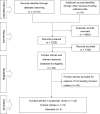Prognostic prediction models for diabetic retinopathy progression: a systematic review
- PMID: 30651592
- PMCID: PMC6707154
- DOI: 10.1038/s41433-018-0322-x
Prognostic prediction models for diabetic retinopathy progression: a systematic review
Abstract
With the increasing incidence of diabetic retinopathy and its improved detection, there is increased demand for diabetic retinopathy treatment services. Prognostic prediction models have been used to optimise services but these were intended for early detection of sight-threatening retinopathy and are mostly used in diabetic retinopathy screening services. We wanted to look into the predictive ability and applicability of the existing models for the higher-risk patients referred into hospitals. We searched MEDLINE, EMBASE, COCHRANE CENTRAL, conference abstracts and reference lists of included publications for studies of any design using search terms related to diabetes, diabetic retinopathy and prognostic models. Search results were screened for relevance to the review question. Included studies had data extracted on model characteristics, predictive ability and validation. They were assessed for quality using criteria specified by PROBAST and CHARMS checklists, independently by two reviewers. Twenty-two articles reporting on 14 prognostic models (including four updates) met the selection criteria. Eleven models had internal validation, eight had external validation and one had neither. Discriminative ability with c-statistics ranged from 0.57 to 0.91. Studies ranged from low to high risk of bias, mostly due to the need for external validation or missing data. Participants, outcomes, predictors handling and modelling methods varied. Most models focussed on lower-risk patients, the majority had high risk of bias and doubtful applicability, but three models had some applicability for higher-risk patients. However, these models will also need updating and external validation in multiple hospital settings before being implemented into clinical practice.
随着糖尿病视网膜病变发病率增加以及检查手段的提高, 对糖尿病视网膜病变治疗服务的需求也随之增加。预后预测模型已被用于优化服务, 但这些模型是为了早期发现威胁视力的视网膜病变, 并主要用于糖尿病视网膜病变的筛查服务。我们希望通过研究现有模型来对转诊到医院的高危患者产生预测能力和适用性。 我们使用与糖尿病, 糖尿病视网膜病变和预后模型相关的搜索术语搜索了MEDLINE, EMBASE, COCHRANE CENTRAL, 会议摘要和所包含出版物的参考列表、或任何研究的设计进行了搜索。 我们对搜索结果进行与研究方向的相关性评估。由两名审稿人分别用指定的标准PROBAST和CHARMS检查列表来评估质量。 22篇关于14个预后模型(包括4篇更新)的文章符合选择标准。11个模型有内部验证, 8个模型有外部评估, 1个模型两者均无。统计量的判别能力在0.57 ~ 0.91之间。研究的误差风险从低到高, 主要是由于需要外部验证或数据缺失。参与者、结果、预测处理和建模方法各不相同。 大多数模型以低危患者为研究对象, 多数模型存在较大的误差风险和不确定适用性, 但有三种模型对高危患者具有一定的适用性。然而, 这些模型被应用到临床实践之前, 还需要在较多医院环境中进行更新和外部验证。 关键词:预后预测模型, 糖尿病视网膜病变, 糖尿病黄斑病变, 进展, 视力丧失, 系统综述
Conflict of interest statement
The authors declare that they have no conflict of interest.
Figures



References
-
- Mathur R, Bhaskaran K, Edwards E, Lee H, Chaturvedi N, Smeeth L, et al. Population trends in the 10-year incidence and prevalence of diabetic retinopathy in the UK: a cohort study in the Clinical Practice Research Datalink 2004–2014. BMJ Open. 2017;7:e014444. doi: 10.1136/bmjopen-2016-014444. - DOI - PMC - PubMed
-
- NHS Diabetic Eye Screening Programme Summary statistics for England. In: England PH, editor. Gov.UK; 2016.
Publication types
MeSH terms
LinkOut - more resources
Full Text Sources
Medical
Miscellaneous

